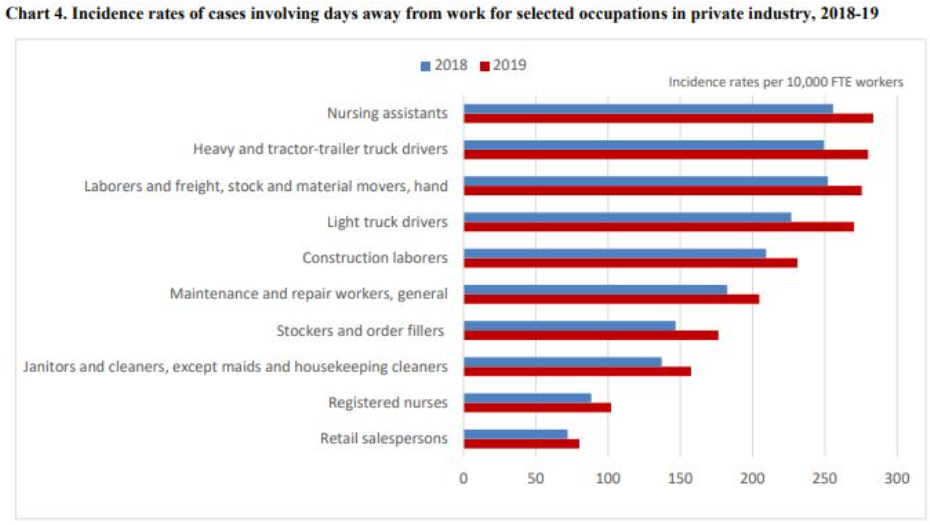
Reports: Occupations with highest rate of injuries requiring days away from work and 25 most dangerous jobs
BLS: Injuries requiring days away from work
In 2019, the private sector reported 888,220 nonfatal workplace injuries and illnesses resulting in days away from work, according to a report from the Bureau of Labor Statistics (BLS). Ten occupations accounted for nearly a third of total private industry cases involving days away from work, and the incidence rate increased in all 10 industries in 2019 compared with 2018.

Nursing assistants reported the highest number of nonfatal injuries requiring days away from work per 10,000 full-time workers, with 283.5 injuries per 10,000 workers in 2019 compared with 255.7 in 2018. Laborers and freight, stock, and material movers, had the highest number of cases resulting in days away from work with 64,160, followed by heavy and tractor-trailer truck drivers with 47,990.
Heavy and tractor-trailer truck drivers had a median number of days away from work of 19 days, down from 23 days in 2018. Light truck drivers had a median of 20 days, an increase of four days from 2018. The median number of days away from work for all private industry workers was eight days in 2019, the same as 2018.
Twenty-five most dangerous jobs
Business insurance analysis firm AdvisorSmith studied the most dangerous jobs in the United States. Going by the sheer number of on-the-job deaths, the delivery drivers classification was by far the most dangerous, accounting for nearly 1,000 (966) deaths in 2018. However, the chances of a fatality are much higher in specific industries when the fatal work injury rate, calculated per 100,000 full-time equivalent workers, is used. In 2018, the average fatality rate among all jobs was 3.4 per 100,000 workers, yet, logging, the most dangerous job, was 33 times that rate.
| Rank | Occupation | Total Deaths | Fatal Injury Rate per 100,000 |
|---|---|---|---|
| 1 | Logging workers | 56 | 111 |
| 2 | Aircraft pilots and flight engineers | 70 | 53 |
| 3 | Derrick and oil field workers | 20 | 46 |
| 4 | Roofers | 96 | 41 |
| 5 | Garbage collectors | 37 | 34 |
| 6 | Iron workers | 15 | 29 |
| 7 | Delivery drivers | 966 | 24 |
| 8 | Farmers | 257 | 26 |
| 9 | Firefighter supervisors | 14 | 20 |
| 10 | Power linemen | 29 | 20 |
| 11 | Agricultural workers | 157 | 20 |
| 12 | Crossing guards | 14 | 19 |
| 13 | Crane operators | 9 | 19 |
| 14 | Construction helpers | 11 | 18 |
| 15 | Landscaping supervisors | 48 | 18 |
| 16 | Highway maintenance workers | 14 | 18 |
| 17 | Cement masons | 11 | 17 |
| 18 | Small engine mechanics | 8 | 15 |
| 19 | Supervisors of mechanics | 46 | 15 |
| 20 | Heavy vehicle mechanics | 27 | 14 |
| 21 | Grounds maintenance workers | 225 | 14 |
| 22 | Police officers | 108 | 14 |
| 23 | Maintenance workers | 64 | 14 |
| 24 | Construction workers | 259 | 13 |
| 25 | Mining machine operators | 9 | 11 |
The study also found that self-employed workers were 3.3 times more likely to die on the job compared with hourly and salaried workers. Wage and salaried workers had an average fatality rate of 2.9 fatalities per 100,000 workers in 2018, while self-employed workers had an average fatality rate of 9.4 per 100,000 workers during the same period.